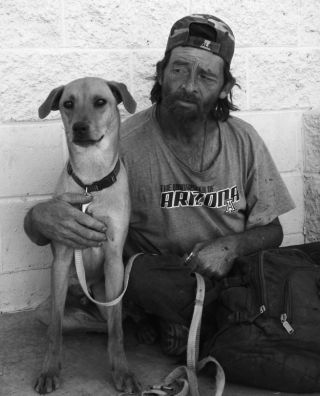Relationships
My Dog Always Eats First: Homeless People and Their Animals
Dogs often are the oxygen and reason for living for homeless people
Posted January 22, 2013
Most of us have seen homeless people on the streets, many accompanied by their nonhuman animal (animal) companions (pets), especially dogs. On any given night there are about 640,000 homeless people in the United States (see also), however estimates vary quite a lot. It's also been estimated that 5-10% of homeless people have dogs or cats as their companions but the numbers vary geographically and it's difficult to come up with highly accurate statistics. Nonetheless, there is a large number of animals who live with homeless humans and in many cases the animals are the lifeline and reason for living for these people without a home, human beings living in a stigmatized and marginalized environment in which few if any would choose to live.
Many homeless people say their dog is their best friend and oxygen
Homeless people have told me on more than one occasion that their animal companion is their best friend and oxygen without whom life wouldn't be worth living. For many their animal friend is their only family. Last year while I was eating lunch in my hometown of Boulder (Colorado) I started talking with a homeless man named Joe and he told me that when he lost his job and became homeless he sold many of his very few possessions so that he could keep his dog, Clive, without whom Joe wouldn't be able to or want to live. I've heard similar stories in cities around the world.
Homeless people are often viewed with suspicion or fear. When people see homeless and their animals they do a number of things. Some give them money or food and some look away. Others judge them unworthy of animal companionship. Whatever the reaction, most of us would have no idea how to survive on the street with (or without) an animal.
A new book by University of Colorado sociology Professor Leslie Irvine is the first to explore what it takes to live on the streets with an animal. Using interviews with more than seventy homeless people in four cities, My Dog Always Eats First reveals what animals mean for homeless people and how they care for their four-legged friends. You can read the introduction to this landmark book here. Dr. Irvine's book provides rich descriptions of how animals provide social and emotional support and protection from harm (see also "My dog feels my pain"), and, in some cases, even helped turn around the lives of people who had few other reasons to live.

Dr. Irvine initially found this research to be very challenging. Because homeless shelters do not typically allow animals, homeless pet owners usually stay on the street and “under the radar.” Then, she made connections with veterinarians who hold street clinics for the pets of the homeless, such as VET SOS in San Francisco and the Mercer Veterinary Clinic for the Homeless in Sacramento, California. She interviewed people at the clinics and even went on veterinary “house calls” into homeless camps, where she would not have ventured on her own.
Building on the work she began in If You Tame Me: Understanding our Connections with Animals, Dr. Irvine continues exploring how animals serve as “significant others” for their human companions. Homeless people told her how their dogs encouraged interaction with others and kept them from becoming isolated. Former addicts and alcoholics described how their animals inspired them to get clean and sober. People who had spent years on the streets explained how they responded to the insults they heard from strangers who thought they should not have a pet. And they praised those who provided pet food and a kind word.
My Dog Always Eats First is full of compelling stories and solid research. It is an inspirational and must-read for anyone who cares about animals and about the people who care for them. I learned a lot from this first-of-a-kind book and encourage others who want to learn more about the nature of human-animal relationships in the wide variety of environments in which we live with other animals to read and share it widely.
The above image, the teaser image, and other heartwarming pictures of homeless people and their animal friends can be seen here.


